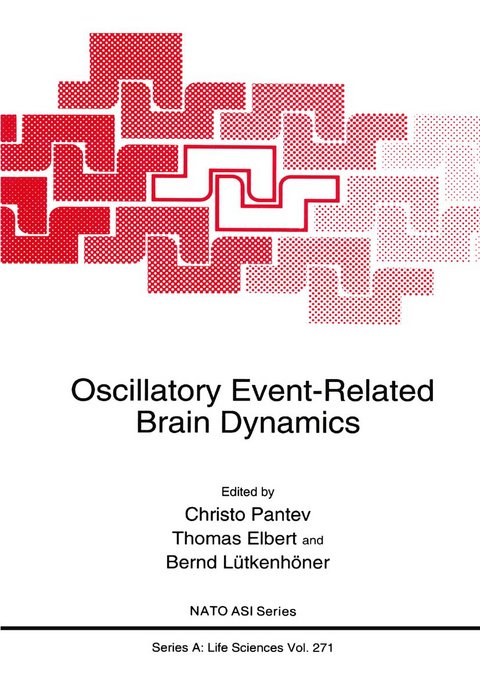
Oscillatory Event-Related Brain Dynamics
Springer-Verlag New York Inc.
978-1-4899-1309-8 (ISBN)
How does the brain code and process incoming information, how does it recog nize a certain object, how does a certain Gestalt come into our awareness? One of the key issues to conscious realization of an object, of a Gestalt is the attention de voted to the corresponding sensory input which evokes the neural pattern underly ing the Gestalt. This requires that the attention be devoted to one set of objects at a time. However, the attention may be switched quickly between different objects or ongoing input processes. It is to be expected that such mechanisms are reflected in the neural dynamics: Neurons or neuronal assemblies which pertain to one object may fire, possibly in rapid bursts at a time. Such firing bursts may enhance the synaptic strength in the corresponding cell assembly and thereby form the substrate of short-term memory. However, we may well become aware of two different objects at a time. How can we avoid that the firing patterns which may relate to say a certain type of move ment (columns in V5) or to a color (V 4) of one object do not become mixed with those of another object? Such a blend may only happen if the presentation times be come very short (below 20-30 ms). One possibility is that neurons pertaining to one cell assembly fire syn chronously. Then different cell assemblies firing at different rates may code different information.
Introductory Talk.- Introductory Remarks.- A Comparative Survey of Event Related Brain Oscillations.- Physiologic and Epileptic Oscillations in a Small Invertebrate Network.- Cortico-Hippocampal Interplay: Synopsis of a Theory.- What Is the Contribution of Axonal Conduction Delay to Temporal Structure in Brain Dynamics?.- Coherent Assembly Dynamics in the Cortex: Multineuron Recordings, Network Simulations, and Anatomical Considerations.- Temporal Aspects of Information Processing in Areas V1 and V2 of the Macaque Monkey.- Oscillations and Synchrony in the Visual Cortex: Evidence for Their Functional Relevance.- Oscillatory and Non-Oscillatory Synchronizations in the Visual Cortex of Cat and Monkey.- Event Related Changes in the 40 Hz Electroencephalogram in Auditory and Visual Reaction Time Tasks.- Attentional Effects on Image-Motion Related Potentials and Spectral Perturbations.- Retinal and Cortical Oscillatory Responses to Patterned and Unpatterned Visual Stimulation in Man.- Low Temporal Frequency Desynchronization and High Temporal Frequency Synchronization Accompany Processing of Visual Stimuli in Anaesthetized Cat Visual Cortex.- High-Frequency Activity (600 Hz) Evoked in the Human Primary Somatosensory Cortex: a Survey of Electric and Magnetic Recordings.- The Transient Auditory Evoked Gamma-Band Field.- Stimulus Frequency Dependence of the Transient Oscillatory Auditory Evoked Responses (40 Hz) Studied by Electric and Magnetic Recordings in Human.- Gamma-Band Responses Reflect Word/Pseudoword Processing.- Time- and Frequency-Domain Analysis of Auditory Evoked Fields.- Electrocortical Rhythms in the Attentive Cat: Phenomenological Data and Theoretical Issues.- Models for the Neuronal Implementation of Selective Visual Attention Based on the Temporal Structure of Neural Signals.- 20 Hz Bursts of Activity in the Cortico-Thalamic Pathway During Attentive Perception.- SSR-Modulation During Slow Cortical Potentials.- Synchronous Oscillations in Sensorimotor Cortex of Awake Monkeys and Humans.- Event-Related Desynchronization (ERD) and 40-Hz Oscillations in a Simple Movement Task.- Subcortical P300-40-Hz Response of the Cat Brain.- Stimulus-Related Oscillatory Responses in the Auditory Cortex of Cats.- Detection of Unaveraged Spontaneous and Event Related Electrophysiological Activities from Focal Regions of the Cerebral Cortex in the Swine.- Cognition and Local Changes in Brain Oscillations.- Tuning and Filtering in Associative Learning.- Possibilities of Functional Brain Imaging Using a Combination of MEG and MRT.
| Reihe/Serie | Nato Science Series: A ; 271 |
|---|---|
| Zusatzinfo | X, 468 p. |
| Verlagsort | New York |
| Sprache | englisch |
| Maße | 178 x 254 mm |
| Themenwelt | Medizinische Fachgebiete ► Chirurgie ► Neurochirurgie |
| Medizin / Pharmazie ► Medizinische Fachgebiete ► Neurologie | |
| Naturwissenschaften ► Biologie ► Zoologie | |
| Naturwissenschaften ► Physik / Astronomie ► Angewandte Physik | |
| ISBN-10 | 1-4899-1309-2 / 1489913092 |
| ISBN-13 | 978-1-4899-1309-8 / 9781489913098 |
| Zustand | Neuware |
| Haben Sie eine Frage zum Produkt? |
aus dem Bereich


